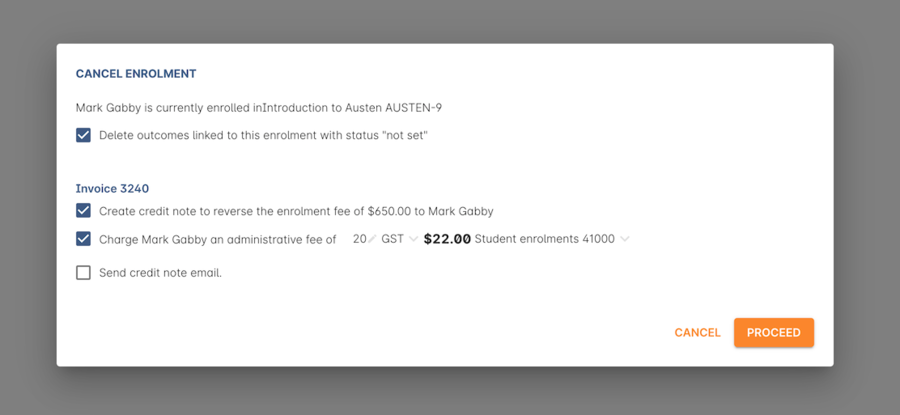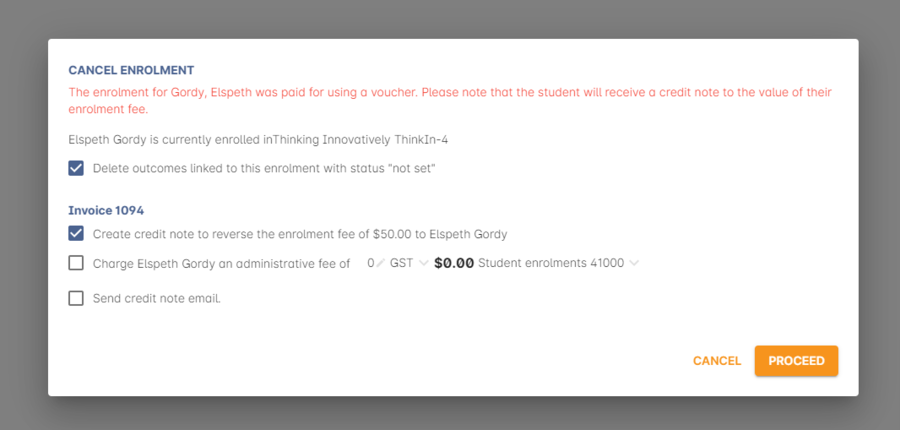Cancelling a single enrolment
It is important to remember that, within the accrual financial system of onCourse, every action has an opposite. When an enrolment is created, an invoice is generated to the payer. When the payer pays the invoice, a payment in record is created. If you want to cancel an invoice or refund a payment, you need to generate an equal and opposite record. This is calles a credit note (a negative invoice) and to give someone back their money, you need to create a payment out using this credit note.
If you need to remove a student from a class due to them withdrawing or failing to attend, you need to cancel their enrolment. If you wish to provide them with a credit note you can do this at the time of the enrolment cancellation.
The first step is to cancel and credit the existing enrolment.
- Find the enrolment in the Enrolments window
- Highlight the enrolment by clicking on it
- Click on the cogwheel in the bottom right-hand corner and choose "Cancel 1 enrolment". This will bring up a dialog with a checkbox offering to also credit the enrolment fee charged - it is unticked by default. If you tick this, you will create a credit note. If you keep it unticked, you will retain all the student’s fees as part of your business income. 99% of the time you want to create a credit note.
- In the cancellation window, choose if you want to send the student a credit note email. If you have not previously agreed to transfer the student to another class, or provide them with a refund, selecting this option will let the student know how much credit they have available with you for future redemption.
- Hit "Proceed".
This process will cancel the enrolment, and create a credit note in the system for the value of the existing enrolment. Note that the credit note will apply to the original payer of the invoice. This may not be the student who enrolled in the class, but their employer, parent or other third party. Read the text in the cancellation window to confirm if the student, and the payer, are the same or different people.
If the invoice originally issued for this enrolment remains unpaid, the credit note created will create an automatic contra payment against that invoice, in effect 'cancelling' it from requiring payment.
If the originating invoice was paid in part or full, the remaining balance on the credit note can be used to contra pay another outstanding invoice from that debtor, enrol in another class, or it can also be refunded to the customer.
Please note that a refund payment back to the student will not be automatically created after cancelling an enrolment. That student might want use the credit to enrol into another class. Or you may wish to contact the student and arrange a refund. The next sections explain these options in detail.
Outcome deletion on cancellation
While all enrolments in onCourse create outcomes, including those in non-VET programs, the outcomes that can cause concern for reporting are those associated with VET enrolments.
During the enrolment cancellation a checkbox is ticked by default that says 'Delete outcomes linked to this enrolment with status "not set"'. If you have not given any outcomes a status yet, this will mean all the outcomes attached to the enrolment will be deleted. This will be desirable for most types of enrolments, where you do not want to report the student as having enrolled in this program at all for AVETMISS purposes. You cannot delete outcomes associated with 'success' or 'unknown' tagged AVETMISS exports, and you also cannot delete outcomes associated with certificates that are not yet revoked.
If the student needs to be reported as a withdrawn student for AVETMISS purposes, you have two options. Either set the value of the outcomes before the cancellation process, and they will be retained by default. Alternatively, you can untick the option 'Delete outcomes linked to this enrolment with status "not set"' so all outcomes, both set and not set, will be retained. To avoid AVETMISS errors, you will need to make sure that any unset outcomes that are retained are given a valid outcomes status, such as 60 - Withdrawn after processing the cancellation.
Retained outcomes attached to cancelled enrolments are reported like all other outcomes. If you want to suppress them from all reporting, set the enrolment to 'Do not report for AVETMISS' within the VET section of the enrolment record.
Charging a cancellation fee
You can also elect to charge a cancellation fee (with or without tax) as per your college policies. The difference between the fee paid, and the cancellation fee charged will be available as credit to the student, or can be refunded to them.
Note that if you charge GST, this amount will be added on to the value you specify. You can see this in the screenshot example below where the user has charged a $20 admin fee on the cancelled enrolment, and that fee also requires a tax named 'GST', which makes the fee $22 (as GST tax defaults to 10%).
You can select to have this administrative fee deposited into the income account of your choice. By default, the income account associated with the enrolment income line will be selected. Any tax component will be credited to the tax account.

Figure 247. Cancelling an enrolment and charging an administrative fee
Cancelling an enrolment paid for by a voucher
On occasion, you may have cause to cancel and enrolment that was originally paid for by an onCourse voucher. If this is the case, a warning will appear in the cancellation window to advise you that a credit note will be made for this student, just like for any other cancelled enrolment. There is no automatic 'crediting' of their original voucher.
If you have a business rule that states that students who paid with vouchers cannot access a refund, then use the credit note to purchase a new voucher for the student that they can again redeem.
In the example below, the enrolment fee of $50 was paid for by a voucher - this can be found by looking at the original invoice for the enrolment.
When the enrolment is cancelled and the credit note created, you could then purchase another $50 voucher for the student with the credit note, or simply enrol them in another class and use the credit note for that.

Figure 248. Cancelling an enrolment that was partially paid for with a voucher
Updated over 1 year ago
